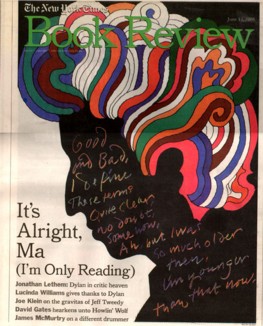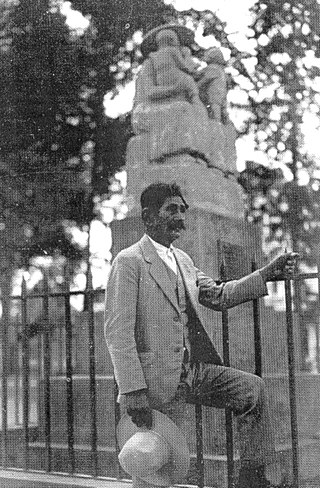
José Vicente Ferrer de Otero y Cintrón was a Puerto Rican actor and director of stage, film and television. He was one of the most celebrated and esteemed Hispanic American actors—or, indeed, actors of any ethnicity—during his lifetime and after, with a career spanning nearly 60 years between 1935 and 1992. He achieved prominence for his portrayal of Cyrano de Bergerac in the play of the same name, which earned him the inaugural Tony Award for Best Actor in a Play in 1947. He reprised the role in a 1950 film version and won an Academy Award for Best Actor, making him both the first Hispanic and the first Puerto Rican–born actor to win an Academy Award.
Doubleday is an American publishing company. It was founded as the Doubleday & McClure Company in 1897. By 1947, it was the largest book publisher in the United States. It published the work of mostly U.S. authors under a number of imprints and distributed them through its own stores.

Nuyorican is a portmanteau word blending "New York" and "Puerto Rican," referring to Puerto Ricans located in or around New York City, their culture, or their descendants. This term is sometimes used for Puerto Ricans living in other areas in the Northeastern US Mainland outside New York State as well. The term is also used by Islander Puerto Ricans to differentiate those of Puerto Rican descent from the Puerto Rico-born.

Hispanic and Latino Americans are Americans that have Spanish or Latin American background, culture, or family origin. These demographics include all Americans who identify as Hispanic or Latino regardless of race. As of 2020, the Census Bureau estimated that there were almost 65.3 million Hispanics and Latinos living in the United States and its territories.
The Wall Street Journal Asia, a version of The Wall Street Journal, was a newspaper that provided news and analysis of global business developments for an Asian audience. Formerly known as The Asian Wall Street Journal, it was founded in 1976 and was printed in nine Asian cities: Bangkok, Hong Kong, Jakarta, Kuala Lumpur, Manila, Seoul, Singapore, Taipei, and Tokyo. Average circulation for 2011 was 83,421. Its largest markets in order of importance were: Hong Kong, Singapore, the Philippines, Japan, Thailand, South Korea, Indonesia, Taiwan, Malaysia, China, India, and Vietnam. The final print edition of the newspaper was published on 9 October 2017.

El Museo del Barrio, often known simply as El Museo, is a museum at 1230 Fifth Avenue in Upper Manhattan, New York City. It is located near the northern end of Fifth Avenue's Museum Mile, immediately north of the Museum of the City of New York. Founded in 1969, El Museo specializes in Latin American and Caribbean art, with an emphasis on works from Puerto Rico and the Puerto Rican community in New York City. It is the oldest museum of the country dedicated to Latino art.

La Opinión is a Spanish-language daily newspaper and website based in Los Angeles, California. It is the largest Spanish-language newspaper in the United States and the second-most read newspaper in Los Angeles. It is published by ImpreMedia, LLC.
Caló is an argot or slang of Mexican Spanish that originated during the first half of the 20th century in the Southwestern United States. It is the product of zoot-suit pachuco culture that developed in the 1930s and '40s in cities along the US/Mexico border.

The New York Times Book Review (NYTBR) is a weekly paper-magazine supplement to the Sunday edition of The New York Times in which current non-fiction and fiction books are reviewed. It is one of the most influential and widely read book review publications in the industry. The magazine's offices are located near Times Square in New York City.
Politico, known originally as The Politico, is an American political digital newspaper company. Founded by American banker and media executive Robert Allbritton in 2007, it covers politics and policy in the United States and internationally, with publications dedicated to politics in the U.S., European Union, United Kingdom, and Canada, among others. Primarily providing distributed news, analysis and opinion online, it also produces printed newspapers, radio, and podcasts. Its coverage focuses on topics such as the federal government, lobbying and the media.

Latina was an American lifestyle, entertainment, beauty and fashion magazine for bilingual Hispanic women published in English by Latina Media Ventures.

Global Finance is an English-language monthly financial magazine. The magazine was founded in 1987 by a team consisting of Joseph D. Giarraputo, the founder and former publisher of Venture, Carl G. Burgen, Stephan Spahn, H. Allen Fernald, and Paolo Panerai. The magazine covers the topic of financial globalization and targets Chairmen, CEOs, Presidents, CFOs, Treasurers, and other financial officers. The magazine is circulated in 158 countries and has 50,050 subscribers and recipients worldwide, BPA Worldwide certified.

American literature in Spanish in the United States dates back as 1610 when the Spanish explorer Gaspar Pérez de Villagrá published his epic poem Historia de Nuevo México. He was an early chronicler of the conquest of the Americas and a forerunner of Spanish-language literature in the United States given his focus on the American landscape and the customs of the people. However, it was not until the late 20th century that Spanish language literature written by Americans was regularly published in the United States.

Holiday was an American travel magazine published from 1946 to 1977, whose circulation grew to more than one million subscribers at its height. The magazine employed writers such as Alfred Bester, Truman Capote, Joan Didion, Lawrence Durell, James Michener, and E. B. White.

The Hispanos of New Mexico, also known as New Mexican Hispanics or Nuevomexicanos, are Hispanic residents originating in the historical region of Santa Fe de Nuevo México, today the US state of New Mexico, southern Colorado, and other parts of the Southwestern United States including Arizona, Nevada, Texas, and Utah. They are descended from Oasisamerica groups and the settlers of the Viceroyalty of New Spain, the First Mexican Empire and Republic, the Centralist Republic of Mexico, and the New Mexico Territory.

Dolores Prida was a Cuban-American columnist and playwright. Catherine E. Shoichet of CNN said that she was a "Latina Dear Abby".
Latino theatre presents a wide range of aesthetic approaches, dramatic structures, and themes, ranging from love, romance, immigration, border politics, nation building, incarceration, and social justice. Whether of a linguistic, ethnic, political, cultural or sexual nature, the plays often have a social justice component involving Latino people living in the United States. The Oxcart by René Marqués, Marisol by José Rivera, and In the Heights by Lin-Manuel Miranda are examples of staged Broadway plays. There is also a strong tradition of Latino avant-garde and absurdist theatre, which double as political satires; prime examples include The Masses are Asses by Pedro Pietri and United States of Banana by Giannina Braschi.

Mardonio Magaña-Camacho (c.1865–1947) also known as Magañita, was a Mexican educator and sculptor known for his folk art stone direct carvings, he was also known to work with wood and mud. He was a self-taught artist inspired by nature, that was "discovered" by artist Diego Rivera. It's said that Diego Rivera was quoted as saying Magaña was, "the greatest contemporary Mexican sculptor".

Julio and Marisol was a bilingual (English/Spanish) public-service advertising campaign that ran in the New York City Subway, promoting condom use to prevent AIDS. The well-known catchphrase was a line from the first installment, in which Marisol sobs, "I love you, but not enough to die for you".














